Eyes and Vision
Blew Nose, Eye Fell Out
In September 1942, a young miner, Ronald Cutler, had finished his shift, so he blew his nose to get the coal dust out. His eye fell out onto his cheek. A superintendent was able to pop it back in, and Cutler appeared "little the worse for the occurrence."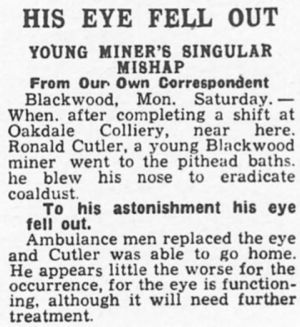
News of the World - Sep 20, 1942
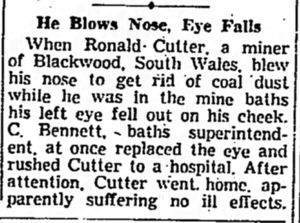
Kingston Daily Freeman - Oct 29, 1942
In April 1899, a similar case was reported in the Southern California Practitioner (which in turn got the story from a German-language paper, the Illinois Staatz Zitung). A glass blower blew his nose violently, and his right eyeball came out of its socket. A colleague was able to put it back in, but on the way to the doctor's office the same thing happened again... and then a third time at the doctor's office.
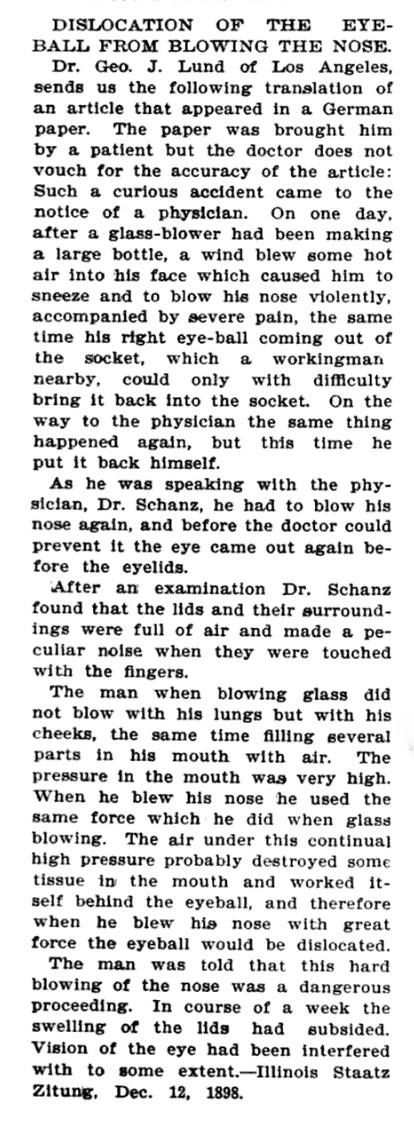
There's an old legend that if you sneeze with your eyes open, your eyeballs will come out. Mythbusters says that's not true, noting, "although a sneeze can erupt from your nose at an explosive 200 miles per hour, it can't transfer this pressure into your eye sockets to dethrone your eyeballs. Plus, there's no muscle directly behind the eye to violently contract and push the orbs outward."
How then do we explain these odd cases of eyeballs coming out when people blow their nose?
Update: I just found a third case of eyeball dislocation following nose blowing, reported by Dr. John Tyler of Kansas City in 1888. His patient, upon waking in the morning, "felt the need of a good, hard blow, and said he really was making an extra effort, when to his horror and amazement he felt his left eye pop right out between the lids, and stick!" His wife popped the eye back in, and the man suffered no apparent damage from the incident.
Posted By: Alex - Sat Dec 10, 2016 -
Comments (1)
Category: Body, Eyes and Vision, Health
Death by Myopia
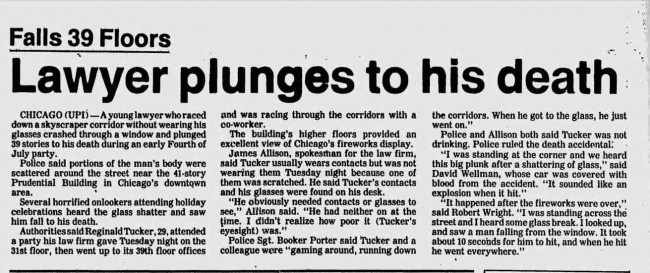
Click to embiggen.
Original story here.
Posted By: Paul - Sun Aug 07, 2016 -
Comments (2)
Category: Death, Law, 1980s, Eyes and Vision
Miss Optometry of 1956
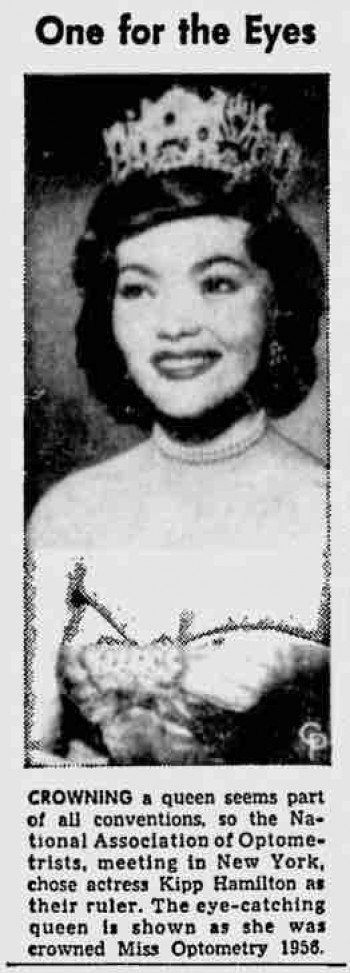
In line with Alex's ceaseless quest for oddball beauty queens, may we present Kipp Hamilton, who actually had a career. But she must have misremembered this honor, for all sources quote Kipp as claiming it happened in the year 1953. But such data has become easier to verify or disprove since Google added its newspaper archives.
Original story here.
Posted By: Paul - Mon Mar 14, 2016 -
Comments (7)
Category: Beauty, Ugliness and Other Aesthetic Issues, Contests, Races and Other Competitions, Movies, 1950s, Eyes and Vision
Universal Colorblindness Test
New stuff from artist Jonathon Keats. He's developed what he calls a "Universal Colorblindness Test," which combines the standard colorblindness test with the new fad for adult coloring books.He describes it as the first colorblindness test that will "adapt to each viewer’s eyesight as the viewer colors them in." He adds, "My test is the first to internalize chromatic subjectivity, ensuring equally positive test results for everybody.”
Available at Walls360.


Posted By: Alex - Wed Jan 13, 2016 -
Comments (4)
Category: Art, Eyes and Vision
Geeky Eyeglasses for Sale
Wow, those are some seriously geeky frames!
I had never heard the phrase "corneal micro lenses" before, but apparently that was the original term for contact lenses. Sounds very cyberpunk even today. I think we should all start telling people, "Yes, I have corneal micro lenses in place."

Posted By: Paul - Wed Dec 02, 2015 -
Comments (3)
Category: Technology, 1950s, Eyes and Vision
Third Eye
The fisherman said he was going to eat the fish. Without knowing why it developed a third eye I wouldn't touch it much less eat it!
Posted By: Alex - Tue Nov 10, 2015 -
Comments (5)
Category: Nature, Fish, Eyes and Vision
Blind People
Posted By: Paul - Thu Nov 05, 2015 -
Comments (6)
Category: PSA’s, 1970s, Differently Abled, Handicapped, Challenged, and Otherwise Atypical, Eyes and Vision
Stare at a stranger day
Get ready for October 15th, when the "World's Biggest Eye Contact Experiment" is scheduled to take place in cities throughout the world. The idea is that on this day lots of people will "share a minutes eye contact with strangers in public to rebuild our sense of shared humanity."If you participate, you'll obviously want to stare into the eyes of someone who's agreed to do likewise. Don't pick just any random stranger on the street and start staring at them. Even though that would probably produce more interesting results.
For more info, check out the website for the event, or its Facebook page.
Posted By: Alex - Thu Oct 08, 2015 -
Comments (3)
Category: Eyes and Vision
Seeing The Light
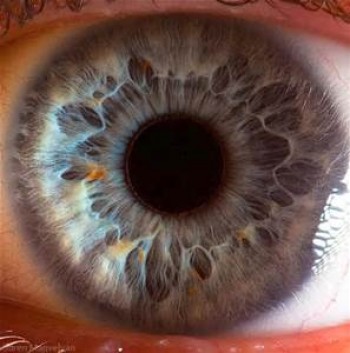
For those who wish to recover their sight promising research is being done by the Universities of Bern, Switzerland and Gottingen, Germany. The process is called Optogenetic therapy and is expected to help those who have lost their sight due to some degenerative diseases of the eyes. Certain proteins are inserted into cells in the retina causing those cells to sense light. The effected cells then act in place of the light sensing cell that were destroyed by the disease process. This treatment has already been successful in returning sight to mice. It is not a cure for all blindness but it is certainly a great step forward in treating blindness due to degenerative diseases. There seems to be a long way to go before it will be ready for human use but the journey has at least begun.
Posted By: Alex - Fri Oct 02, 2015 -
Comments (2)
Category: Science, Universities, Colleges, Private Schools and Academia, Eyes and Vision
Erismann and Kohler: Inversion Goggles
"The movie documents a classic experiment conducted in 1950 by Ivo Kohler and Theodor Erismann at the university of Innsbruck, Austria. Erismann is the older person the movie, and Kohler, his research assistant at that time, is the person wearing the inversion goggles. Subtitles are all in German."
Full story here.
Posted By: Paul - Sun Mar 15, 2015 -
Comments (2)
Category: Science, Experiments, 1950s, Eyes and Vision

| Who We Are |
|---|
| Alex Boese Alex is the creator and curator of the Museum of Hoaxes. He's also the author of various weird, non-fiction, science-themed books such as Elephants on Acid and Psychedelic Apes. Paul Di Filippo Paul has been paid to put weird ideas into fictional form for over thirty years, in his career as a noted science fiction writer. He has recently begun blogging on many curious topics with three fellow writers at The Inferior 4+1. Contact Us |




